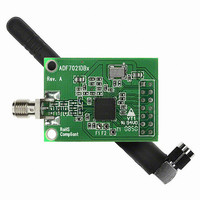EVAL-ADF7021-NDBZ2 Analog Devices Inc, EVAL-ADF7021-NDBZ2 Datasheet - Page 38

EVAL-ADF7021-NDBZ2
Manufacturer Part Number
EVAL-ADF7021-NDBZ2
Description
860 MHz To 870 MHz
Manufacturer
Analog Devices Inc
Type
Transceiver, FSKr
Datasheet
1.ADF7021-NBCPZ-RL.pdf
(64 pages)
Specifications of EVAL-ADF7021-NDBZ2
Frequency
860MHz ~ 870MHz
Lead Free Status / RoHS Status
Lead free / RoHS Compliant
For Use With/related Products
ADF7021-N
Lead Free Status / RoHS Status
Lead free / RoHS Compliant
1
ADF7021-N
APPLICATIONS INFORMATION
IF FILTER BANDWIDTH CALIBRATION
The IF filter should be calibrated on every power-up in receive
mode to correct for errors in the bandwidth and filter center
frequency due to process variations. The automatic calibration
requires no external intervention once it is initiated by a write
to Register 5. Depending on numerous factors, such as IF filter
bandwidth, received signal bandwidth, and temperature variation,
the user must determine whether to carry out a coarse
calibration or a fine calibration.
The performance of both calibration methods is outlined in
Table 21.
Table 21. IF Filter Calibration Specifications
Filter Calibration
Method
Coarse Calibration
Fine Calibration
Calibration Setup
IF Filter calibration is initiated by writing to Register 5 and
setting the IF_CAL_COARSE bit (R5_DB4). This initiates a
coarse filter calibration. If the IF_FINE_CAL bit (R6_DB4) has
already been configured high, the coarse calibration is followed
by a fine calibration, otherwise the calibration ends.
Once initiated by writing to the part, the calibration is performed
automatically without any user intervention. Calibration time is
200 μs for coarse calibration and a few milliseconds for fine
calibration, during which time the ADF7021-N should not be
accessed. The IF filter calibration logic requires that the
IF_FILTER_DIVIDER bits (R5_DB[5:13]) be set such that
The fine calibration uses two internally generated tones at
certain offsets around the IF filter. The two tones are attenuated
by the IF filter, and the level of this attenuation is measured
using the RSSI. The filter center frequency is adjusted to allow
equal attenuation of both tones. The attenuation of the two test
tones is then remeasured. This continues for a maximum of
10 RSSI measurements, at which stage the calibration algorithm
sets the IF filter center frequency to within 0.6 kHz of 100 kHz.
The frequency of these tones is set by the IF_CAL_LOWER_
TONE_DIVIDE (R6_DB[5:12]) and IF_CAL_UPPER_TONE_
DIVIDE (R6_DB[13:20]) bits, outlined in the following equations:
After calibration.
IF
_
FILTER
XTAL
_
[Hz]
DIVIDER
Center Frequency
Accuracy
100 kHz ± 2.5 kHz
100 kHz ± 0.6 kHz
=
50
1
kHz
Calibration
Time (Typ)
200 μs
8.2 ms
Rev. 0 | Page 38 of 64
Lower Tone Frequency (kHz)
Upper Tone Frequency (kHz)
It is recommended to place the lower tone and upper tone as
outlined in Table 22.
Table 22. IF Filter Fine Calibration Tone Frequencies
IF Filter
Bandwidth
9 kHz
13.5 kHz
18.5 kHz
Because the filter attenuation is slightly asymmetrical, it is
necessary to have a small offset in the filter center frequency to
give near equal rejection at the upper and lower adjacent
channels. The calibration tones given in Table 22 give this small
positive offset in the IF filter center frequency.
In some applications, an offset may not be required, and the
user may wish to center the IF filter exactly at 100 kHz. In this
case, the user can alter the tone frequencies from those given in
Table 22 to adjust the fine calibration result.
The calibration algorithm adjusts the filter center frequency
and measures the RSSI 10 times during the calibration. The
time for an adjustment plus RSSI measurement is given by
It is recommended that the IF tone calibration time be at least
800 μs. The total time for the IF filter fine calibration is given by
IF Filter Fine Calibration Time = IF Tone Calibration Time × 10
When to Use Coarse Calibration
It is recommended to perform a coarse calibration on every
receive mode power-up. This calibration typically takes 200 μs.
The FILTER_CAL_COMPLETE signal from MUXOUT can be
used to monitor the filter calibration duration or to signal the
end of calibration. The ADF7021-N should not be accessed
during calibration.
IF
IF_CAL_LOW
IF_CAL_UPP
Tone
Calibratio
ER_TONE_DI
ER_TONE_DI
XTAL
XTAL
Lower Tone
Frequency
78.1 kHz
79.4 kHz
78.1 kHz
n
Time
=
VIDE
VIDE
IF_CAL_DWE
×
×
2
2
SEQ
Upper Tone
Frequency
116.3 kHz
116.3 kHz
119 kHz
CLK
LL_TIME












